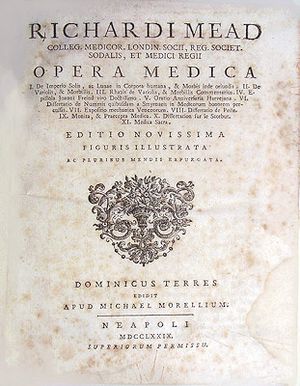Richard Mead facts for kids
Quick facts for kids
Richard Mead
|
|
|---|---|
 |
|
| Born | 11 August 1673 Stepney, London
|
| Died | 16 February 1754 (aged 80) |
| Nationality | English |
| Known for | Epidemiology |
| Scientific career | |
| Fields | Medicine |
| Doctoral advisor | JG Graevius |
Richard Mead (born August 11, 1673 – died February 16, 1754) was an important English doctor. He was known for his work on how diseases spread. His book, A Short Discourse concerning Pestilential Contagion, and the Method to be used to prevent it (1720), helped people understand how to stop illnesses from spreading.
Contents
Life of a Famous Doctor
Richard Mead was born in Stepney, London. He was one of thirteen children. His father, Matthew Mead, was a minister. Richard studied in Utrecht for three years. He then decided to become a doctor. He went to Leiden to learn more about medicine.
In 1695, he finished his studies in Padua. He became a doctor there. In 1696, he came back to London. He quickly became a very successful doctor.
Early Career and Achievements
In 1702, Richard Mead wrote a book called Mechanical Account of Poisons. The next year, in 1703, he joined the Royal Society. This is a famous group for scientists. He wrote a paper for them about scabies, which is a skin condition caused by tiny mites.
In the same year, he became a doctor at St. Thomas' Hospital. He also gave lessons on how the human body works. When another famous doctor, John Radcliffe, died in 1714, Mead became the top doctor in England. He even helped Queen Anne when she was dying. In 1727, he became the doctor for King George II. He had also been the doctor for George when he was a prince.
Helping Children at the Foundling Hospital
While working for the king, Dr. Mead helped start a new charity. This was the Foundling Hospital. It was a home for children who had been abandoned. Dr. Mead was one of its first leaders. He also gave advice on all medical matters.
Thanks to him, the Foundling Hospital had a special sick room. It also had its own pharmacy (a place to get medicines). He even suggested that the building should have a large courtyard. This was so the children could play and exercise. A painting of Dr. Mead is still displayed at the Foundling Museum. This helps everyone remember his important work.
Mead's Collections and Legacy
Dr. Mead was also a member of the Royal Society. He was a Fellow of the College of Physicians. He loved collecting things. He had many paintings, rare books, and old sculptures. He also collected gems and animal specimens.
He had a huge library in his house in Bloomsbury. It had 10,000 books! He let other people study his collections. After he died, it took 56 days to sell all his books. His other collections were also sold at auction.
Dr. Mead had a country home in Old Windsor. But he died at his London house in Bloomsbury in 1754. His London home later became part of Great Ormond Street Hospital. He was buried in Temple Church. There is also a monument to him in Westminster Abbey.
Important Works
Besides his book on poisons, Dr. Mead wrote many other important works:
- De Imperio Solis ac Lunae in Corpora humana, & Morbis inde oriundis (1704): This book was about how the sun and moon might affect human bodies and cause diseases.
- A Short Discourse concerning Pestilential Contagion, and the Method to be used to prevent it (1720): This was his famous book about stopping the spread of diseases like the plague.
- De variolis et morbillis dissertatio (1747): This discussed smallpox and measles.
- Medica sacra, sive de morbis insignioribus qui in bibliis memorantur commentarius (1748): This book looked at important illnesses mentioned in the Bible.
- On the Scurvy (1749): This was about scurvy, a disease caused by a lack of vitamin C.
- Monita et praecepta medica (1752): This book contained medical advice and rules.
- Pharmacopoeia Meadiana (1756, published after his death): This book shared his medical recipes and treatments.



